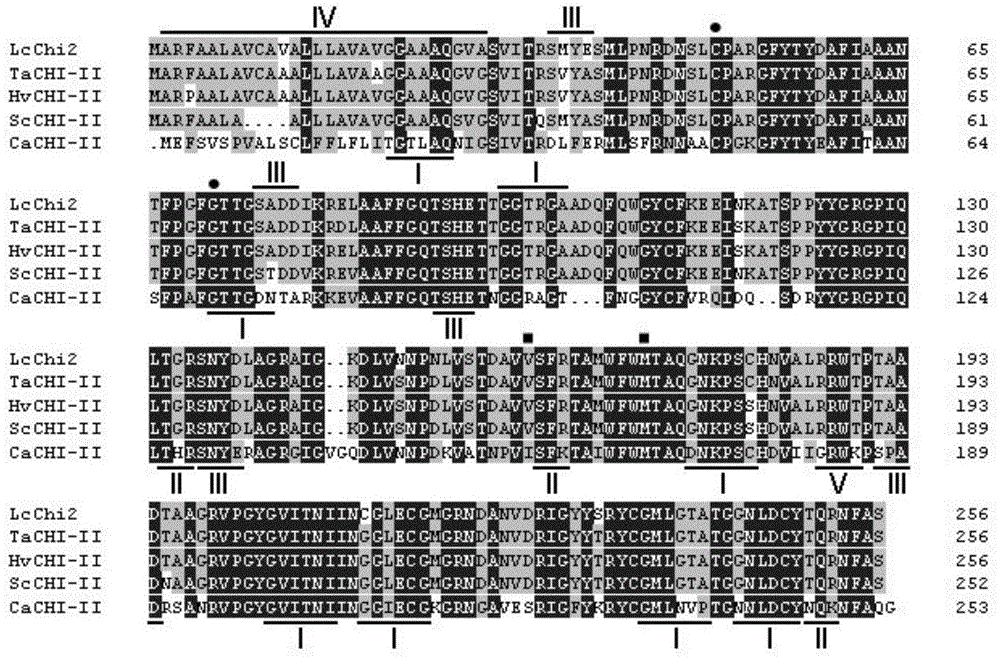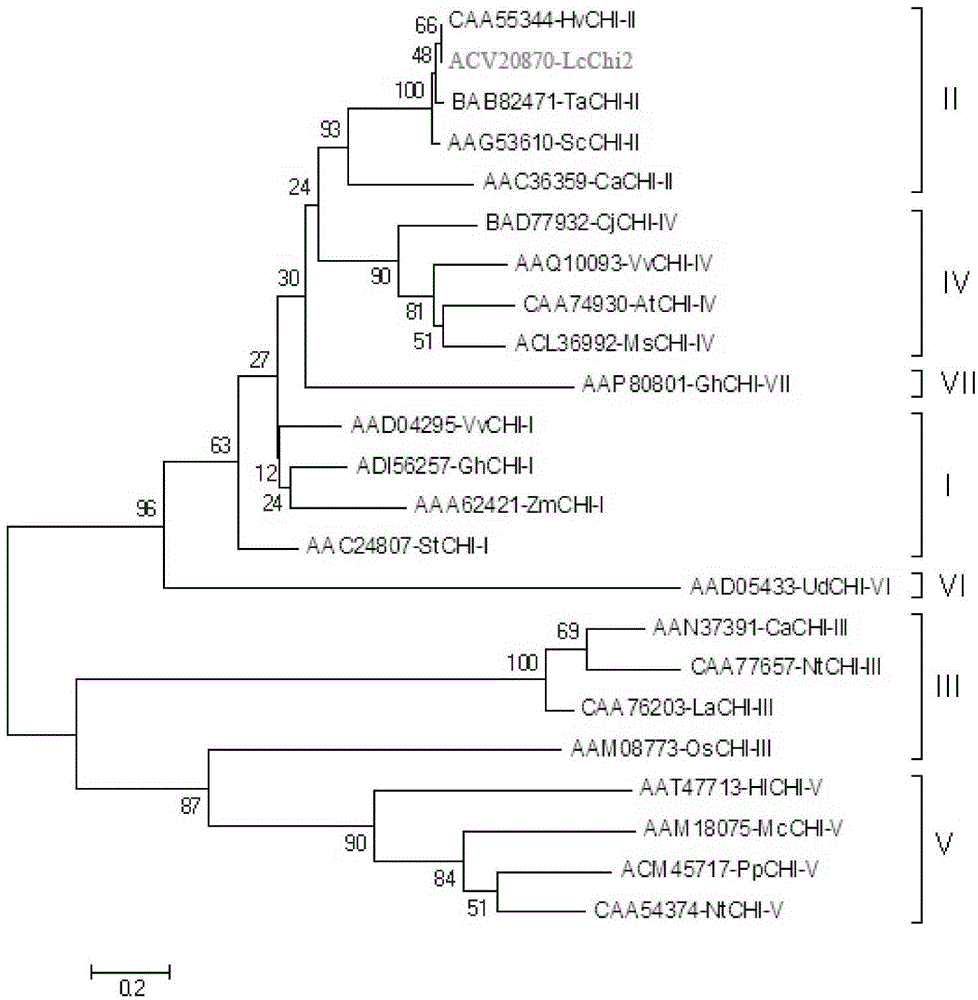Application of Leymus chinensis Trin chitinase (LcChi2) gene in improving cold resistance of plants
A chitinase and cold tolerance technology is applied in the application field of Leymus chinensis chitinase LcChi2 gene in improving the cold tolerance of plants, and can solve the problems that the research on the Leymus chinensis chitinase LcChi2 gene has not been reported, etc. The method is simple and effective, has good application prospects, and improves the effect of plant cold tolerance
- Summary
- Abstract
- Description
- Claims
- Application Information
AI Technical Summary
Problems solved by technology
Method used
Image
Examples
Embodiment 1
[0069] Example 1: Cloning of Leymus chinensis LcChi2 gene
[0070] (1) Extraction of RNA: Select Leymus chinensis at the three-leaf stage as the experimental material, after 100mM Na 2 CO 3 After treatment, Leymus chinensis leaves were taken in a mortar and ground into powder with liquid nitrogen; total RNA was extracted by RNAiso at room temperature; the quality and purity of total RNA were detected by micro-spectrophotometer and agarose gel electrophoresis.
[0071] (2) Obtaining the 3′ end fragment of the LcChi2 gene: using the SMARTTM RACE cDNA Amplification Kit kit from Clontech Company, the 3′ end fragment of the LcChi2 gene of Leymus chinensis was obtained; according to the esterase gene EST (CD808914) reported on Genbank Sequence information Design 3'-RACE primers of Leymus chinensis LcChi2 gene, the primer sequence is as follows:
[0072] Forward primer: 5′-CCGACCAGTTCCAATGGGGCT-3′
[0073] 5′-CCGCCGCCAACACCTTCC-3′
[0074] Reverse primer: 5′-GGCCACGCGTC...
Embodiment 2
[0083] Example 2: Sequence Analysis of Leymus chinensis LcChi2 Gene
[0084] Sequence analysis of LcChi2 gene of Leymus chinensis LcChi2: multiple sequence alignment analysis of chitinase LcChi2 gene of Leymus chinensis and homologous genes in other plants, using DNAMAN software for sequence comparison, homologous genes in other plants and other plants The accession numbers of the source genes in GenBank are: Hordeum vulgare (CAA55344), Triticum aestivum (BAB82471), Secale cereale (AAG53610) and Capsicum annuum (AAC36359), these four homologous gene sequences are composed of methionine ( Met) started.
[0085] like figure 1 As shown, the black box represents a completely consistent sequence, the gray box represents a similar sequence, and the Roman numerals above the black line represent possible motifs (conserved sequences in biological macromolecules such as DNA and proteins, in the structure of trans-acting factors Among them, the motif generally refers to the basic struc...
Embodiment 3
[0086] Example 3: Construction of phylogenetic tree of Leymus chinensis LcChi2 gene
[0087] Construction of phylogenetic tree of chitinase LcChi2 gene of Leymus chinensis: MEGA 3.1 and Clustal X programs were used to construct phylogenetic tree and evaluate phylogenetic tree. The construction of the phylogenetic tree can predict or analyze the possible function of the target gene, for example, the target gene is likely to be the same or similar to the known gene closest to it. Accession number, genotype and species such as figure 2 Shown:
[0088] CAA55344-HvCHI-II: Barley chitinase [Hordeum vulgare subsp.vulgare];
[0089] ACV20870-LcChi2: Leymus chinensis [Leymus chinensis];
[0090]BAB82471-TaCHI-II: Wheat chitinase 1 [Triticum aestivum];
[0091] AAG53610-ScCHI-II: Rye 24.8kDa class II endochitinase-antifreeze protein precursor [Secale cereale];
[0092] AAC36359-CaCHI-II: Capsicum chitinase class II [Capsicum annuum];
[0093] BAD77932-CjCHI-IV: Cryptomeria class ...
PUM
 Login to View More
Login to View More Abstract
Description
Claims
Application Information
 Login to View More
Login to View More - R&D
- Intellectual Property
- Life Sciences
- Materials
- Tech Scout
- Unparalleled Data Quality
- Higher Quality Content
- 60% Fewer Hallucinations
Browse by: Latest US Patents, China's latest patents, Technical Efficacy Thesaurus, Application Domain, Technology Topic, Popular Technical Reports.
© 2025 PatSnap. All rights reserved.Legal|Privacy policy|Modern Slavery Act Transparency Statement|Sitemap|About US| Contact US: help@patsnap.com



